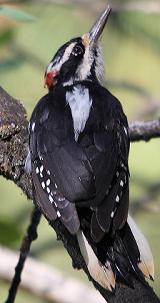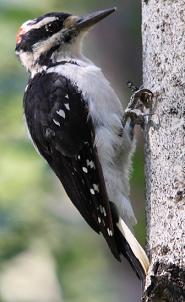Hairy Woodpecker 
Identification and Pictures
(Picoides villosus)
Hairy woodpeckers are a medium sized woodpecker
about 8 1/2 to 10 1/2 inches. They have a white back, and
under parts. The wings are black with white spots.
Their inner tail feathers are black, and the outer tail
feathers are white. They
have a black and white striped head with a large bill,
useful for probing bark for insects, and excavating cavities
for nesting. The
males have a red patch on the back of their head. The
females look like the males but do not have the red
patch. Juvenile birds have red feathers in their
crown. They launch into short, rapid flights as
they move from tree to tree in search of insects.
Hair woodpeckers are often confused with Downy
woodpeckers. The Downy is smaller, and the bill is
much smaller in relation to the head.
Photos by Keith
Lee. The camera I use is the Canon
EOS 40D. Visit All-birds store

Sound
The voice is a high rattle, and the call is
sharp peek. During conflicts they will make shrill cries
while holding their wings over their heads. Sound
Preferred Habitat
Hair Woodpeckers can be found year round
across much of North America. They like wooded lands, mountain forests,
and river groves, both coniferous, and deciduous forests. You may also see the birds in
parks or your back yard.
Breeding and Nesting
Female Hairy woodpeckers choose the territory,
and attract a mate by drumming. During courting the
birds bob their heads from side to side, stretch out their necks,
with their bills pointed high in the air, and circle a tree
trunk while flicking their wings. They will also do drumming
duets. They form pairs in late
winter. The two birds will excavate holes for nesting
and roosting in a tree. They like to nest in deciduous trees even though they prefer to spend more time in
coniferous trees. The inside of the nest is usually bare
except for wood chips at the bottom. The female will lay 3 to 6 glossy white
eggs, and
both parents will incubate them for about 14 days. The
female incubates the eggs during the day, and the male
incubates them at night. Both
birds will feed the young, which will leave the nest in about
30 days. The young birds will stay with the parents for
a couple more weeks. The pair will normally raise one
brood a year.
Food
Hairy woodpecker's main diet is insects, but they also eat fruits, berries,
nuts and sap from Sapsucker
holes. They forage for insects by probing the bark on
tree trunks, and branches with their sharp beaks. They
can hear insects under the barks as well as feel their
vibrations. Their long tongues are covered with a
sticky substance that insects stick to. They will visit backyard
seed, and suet
feeders.
For more on food
and feeding click here.
For more on feeders click here.
To learn about other favorite
birds click here.

|
